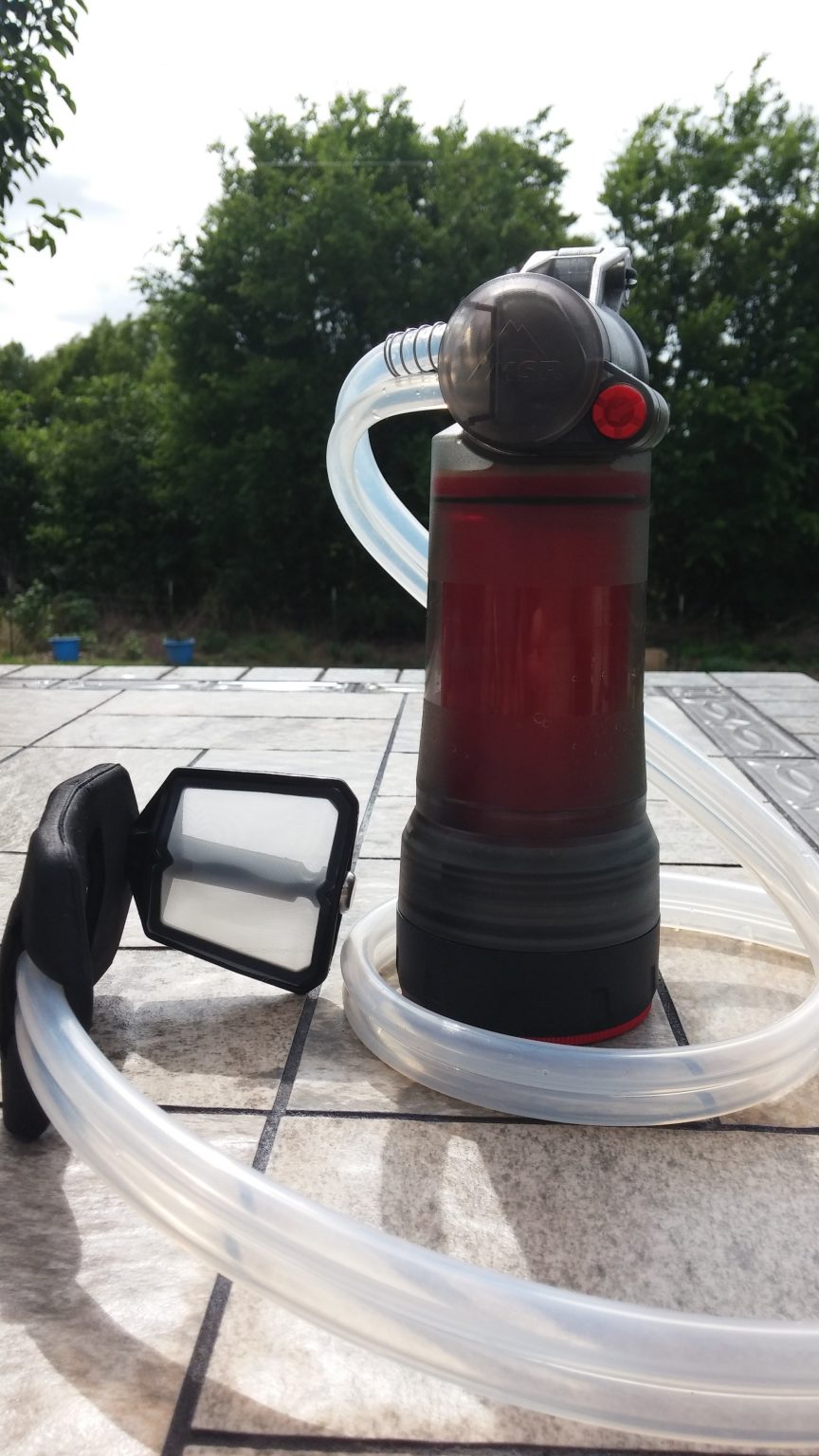This review is a bit of a departure from the other content on this site. It is a review of the newly released MSR Guardian water purifier. Although it is not firearm or shooting related I know a lot of our readers love the outdoors so I hope you find this relevant.

Before I get into to the details of the review some background on portable water filters may be helpful. Backcountry hikers, hunters, and backpackers often have access to water but best practice dictates that this water be treated before use. Dirt, bacteria, protozoa, and less frequently viruses can be present in the water. The standard methods to treat the water was either by using chemicals or using a filter. Chemicals are lightweight but can be expensive and require a long contact time with the water. Typically the water needs to sit around 30 minutes before it is used. Another disadvantage is that many chemicals don’t treat cryptosporidium, one of the bigger concerns in backcountry water.
Filters are highly effective against sediment, bacteria, and protozoa. A filter by definition removes bacteria and protozoa but not viruses. A purifier is defined as a device that removes viruses in addition to bacteria and protozoa. In the past filters tended to be heavier, typically around 16oz. Highly popular now is the sawyer line of filters that are light weight and well reviewed.
I have owned a MSR miniworks water filter for years. It is a pump filter that uses a ceramic element. The filter attaches directly to a nalgene bottle or any product with the same threads. The filter has a handle that is pumped and water is sucked through a tube from source water and pushed through the device into a bottle.
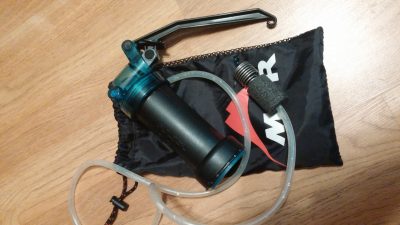
MSR miniworks

older ceramic element
Fortunately for the consumer there is a myriad of products on the market now that fill any niche for your particular needs. But for a pump purifier (not filter) that did not use chemicals there has, until now only been one product on the market. For years the first need xle water purifier was the only hand pump water purifier on the market. This product worked well but had a relatively low filter life of 150-180 gallons. The filter cartridge needed to be replaced after this. The distinction between a pump purifier that uses chemicals and one that doesn’t is important. If the device needs chemicals to kill viruses you might as well just use the chemicals by themselves and not bother with the filter. Its only advantage is that it removes sediment.
REVIEW
The MSR Guardian was released in 2016. What makes it so unique is that it is a handheld pump operated purifier. It does not use chemicals to remove viruses. It uses hollow fiber technology. MSR states that the filter was designed at the request of the U.S. military and that it meets NSF protocol P248. I scoured the internet for info on NSF protocol P248. It was difficult to find information and what I did find was technical. The main idea was that the purifier removes bacteria, protozoa, and viruses in a worst case scenario well enough to make the water safe to drink.
There are some other purifiers on the market that use hollow fiber technology. These systems are gravity fed. Another very important feature of the guardian is that it automatically back flushes 10 percent of its water to clean the hollow fiber cartridge. The unit is self cleaning. MSR states that the cartridge is expected to have a life of 10,000 liters (2,600 Gallons). This is exceptional and I believe that the unit’s auto cleaning ability plays a big part in this. In comparison, MSRs other water filters have an expected filter life of 1,000 to 2,000 liters, this is typical for a ceramic element. For an average user the MSR guardian would last a lifetime. Another advantage of the guardian is that is withstands freezing and was drop tested to 6ft. Do not attempt to use the unit before thawing if it has frozen.

attached to nalgene bottle
Now onto actual use. I purchased this unit myself and it was not provided by MSR. Within 3 hours of having the purifier I managed to mess it up. I’m sure there is a joke about cops in there somewhere. Being curious I wanted to look at the cartridge. I unscrewed it and put it back in a couple times. Thankfully the body of the unit is translucent. The o-ring at the top of the cartridge had become dislodged and was no longer held in its groove.
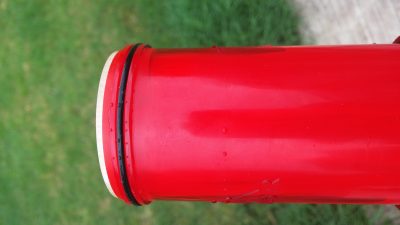
O-ring inside groove.
I believe as I was screwing the cartridge into the unit there was too much friction against the unit body and it pulled it out of the groove. I placed a small amount of lubricant on the o-ring and put it back together. I thought I had fixed it but noticed at the rear of the unit the o-ring was sagging a little bit. I again removed the cartridge and placed a small amount of lubricant on the o-ring. This time I also put some water on the o-ring. I screwed the cartridge back in slowly watching the o-ring position and there were no problems. I would suggest not removing the cartridge unless you are replacing it as there is no reason to do so. If you do, make sure the o-ring stays in its groove.

hollow fibers encased in epoxy like substance
I pumped some tap water through the unit to get some flow rates. The published rate is 2.5 liters per minute using 70 strokes per minute. I did not count my strokes for the test but pumped at a comfortable rate that I would naturally use. This resulted in pumping a liter in 40 seconds. When I pushed it a little bit I pumped a liter in 30 seconds. With the published rate you would get a liter in 20 seconds. I believe this is possible with the unit but it would be a workout. For comparison my older MSR miniworks has a clean element and pumped a liter in 90 seconds using a natural pump rate. The purifier makes water very fast and is one of the fastest pump units on the market.
The published weight of the guardian is 17.3 ounces. Unfortunately I did not weigh it new out of the box. After using the filter and pumping out all the water I got a weight of 1lb 8.4oz with the included bag (bag weighs 2.4 ounces). This comes out to 7.1 ounces over published weight or 4.7ounces over if you don’t include the bag. Keep in mind that this weight is after using the purifier and there is still water inside of it. I pumped the unit until water stopped flowing out and shook out the hose. There is still some water inside and it is designed this way. But this gives a realistic weight of what you will be carrying. For comparison my MSR miniworks gained 1.9 ounces from completely dry after being used and pumping the water out of the unit.
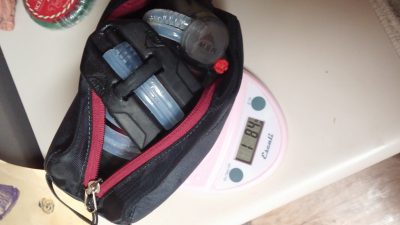
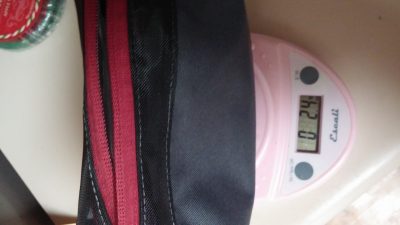
An important instruction in the manual is that the element not be removed and allowed to dry out. The instructions state that if this is done the purifier will not work properly. They do not elaborate on this. I have seen other filters with similar hollow fiber technology. Some of their warnings on dry cartridges state that contaminants in the water can dry onto the fibers and clog them. Calcium deposits are specifically mentioned as a concern. MSR instructions go on to state that if the cartridge is allowed to dry out you need to contact MSR. I am curious why there are not more details. Again, other manufacturers state that if this happens soaking the cartridge in hot water or flushing it with vinegar to remove calcium may fix the issue.
MSR includes instructions for cleaning before and after long term storage. This involves pumping water with bleach in it through the unit followed by clean water. My non technical background suggests that if you are going to store the unit for a long period of time after following the instructions for the bleach water it may be a good idea to flush the unit using distilled or RO water. This would eliminate the possibility of using very hard tap water like we have in Texas which may have a bigger risk of leaving behind mineral deposits.

prefilter oriented by float on top

second hose discharges the backflush
I purchased my first MSR product in 1997. They have always done an excellent job of making gear that is easy to maintain in the field. The MSR Guardian is no different. Although I did read the instructions I could have disassembled and repaired the pump without them. The only part that requires a tool is the pressure relief valve and anything with a flat edge such as a coin will work. All the other parts of the pump can be taken apart by hand. MSR sales a separate maintenance kit that includes all the o-rings and other minor parts that may experience wear.
The one feature that the guardian does not have is carbon in the element. Some filters use carbon as part of their element. Carbon does not remove diseases but it can remove some chemicals. Carbon is the main component in the filter in your fridge or brita filter. Again with my vast non technical background my guess is that carbon is not feasible for inclusion with hollow fiber type cartridges. Carbon has a finite life. It is like a sponge that soaks up chemicals and other contaminants in the water. Once it is full it is no longer effective. The life of the guardian’s element is far beyond what any carbon would be capable of processing. It would be nice if MSR had an attachable carbon module for the bottom of the unit or a inline module for hydration reservoirs.
The MSR guardian attaches directly to any nalgene style threads. It also has a nipple that a piece of ¼ inside diameter tubing can be attached to. The tubing attaches securely to the nipple and I have not had issues with it accidentally pulling off. This is my favorite way to use the unit. I attach the tubing to the nipple and then I attach it to my camelbak filter adapter on my water reservoir. The water is pumped directly into my water reservoir and I never have to remove the reservoir from my pack.
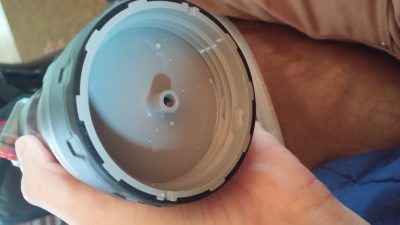

filter adaptor

bite piece removed and unit attached
Conclusion
This is a remarkable product that is in a class of its own. Its main disadvantage is that it is heavy. It also has a high cost. But if you take into account that it is expected to process enough water for a lifetime the cost is mitigated. It also has the relatively unique feature of being able to remove viruses. The biggest question is if you need this capability. There are far cheaper and or lighter options on the market that will remove bacteria and protozoa. If you have the need or desire for a pump filter that removes everything and don’t mind the weight the MSR Guardian is the best option out there.

